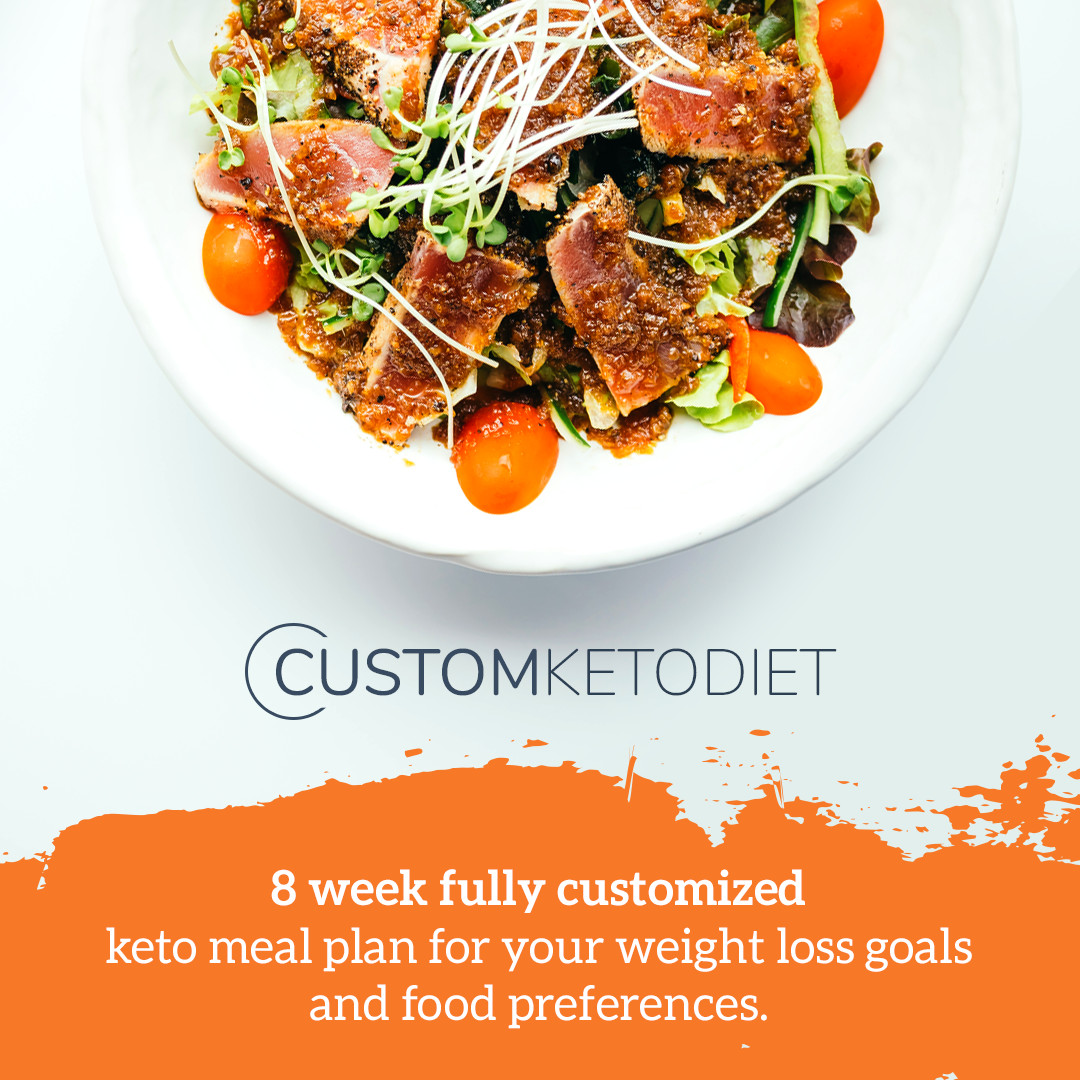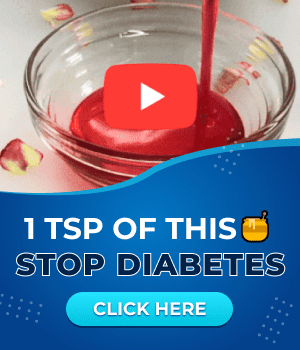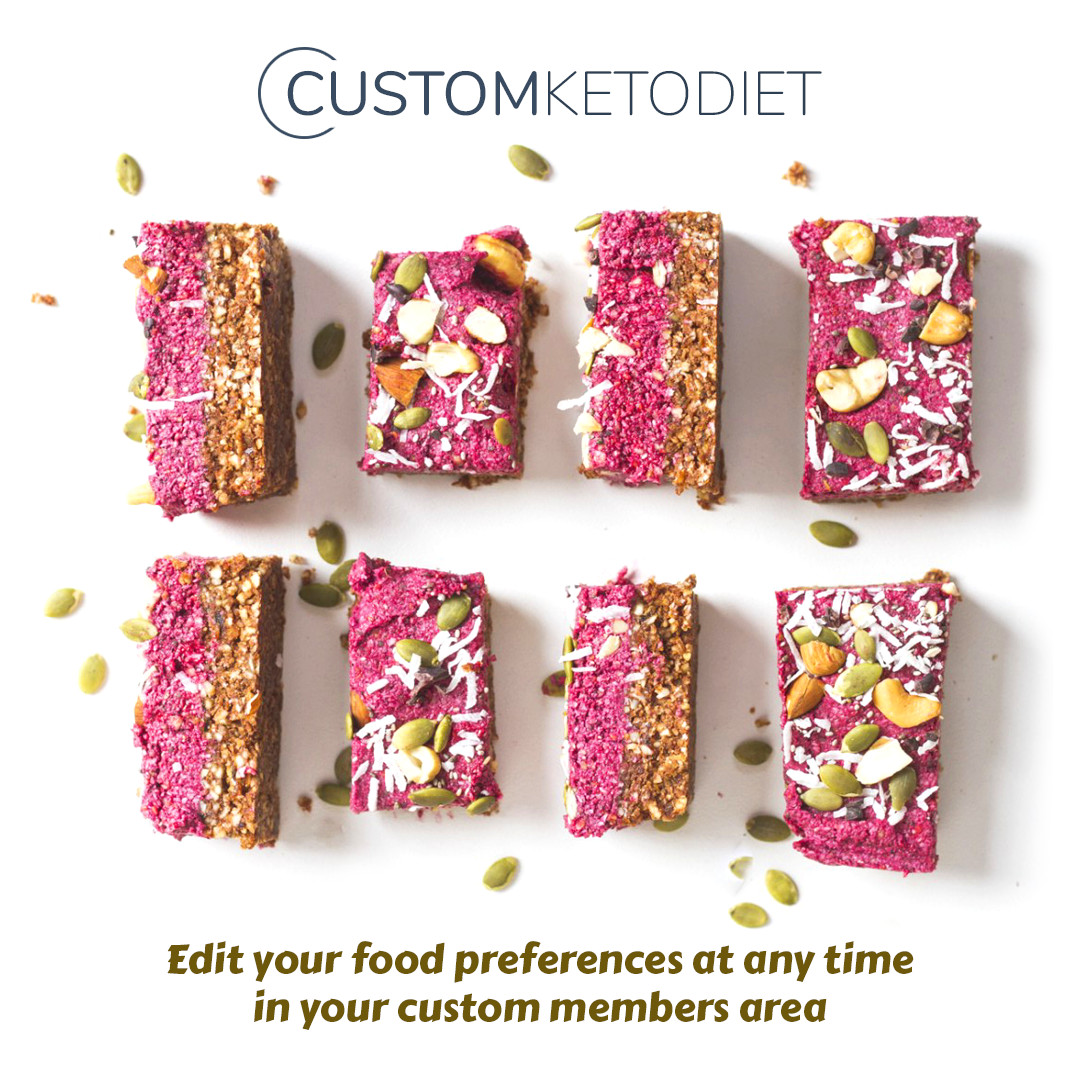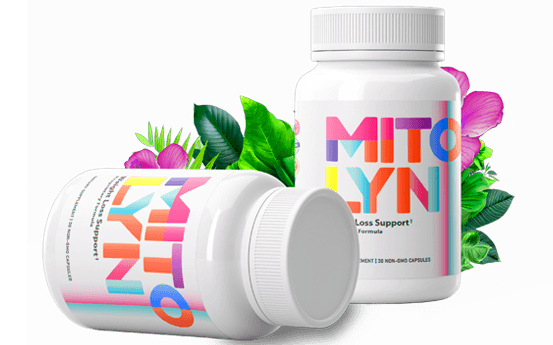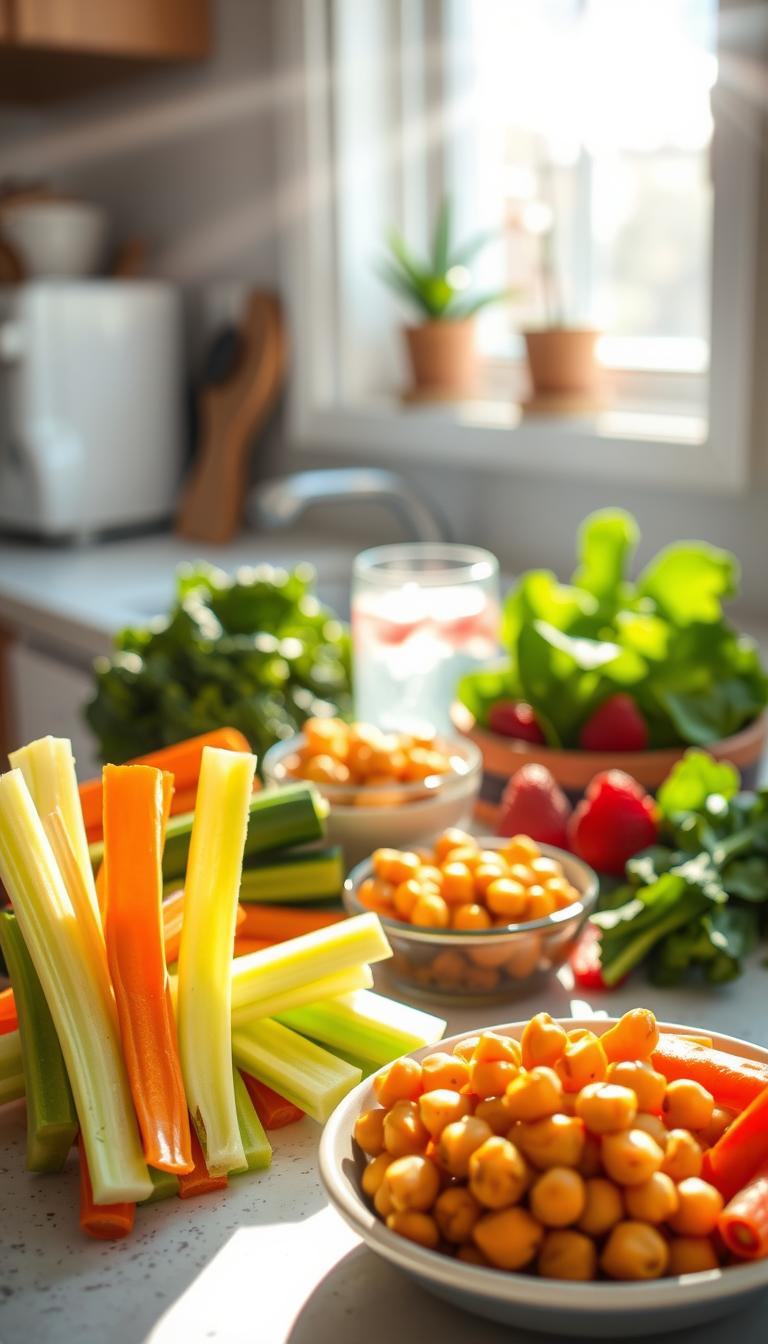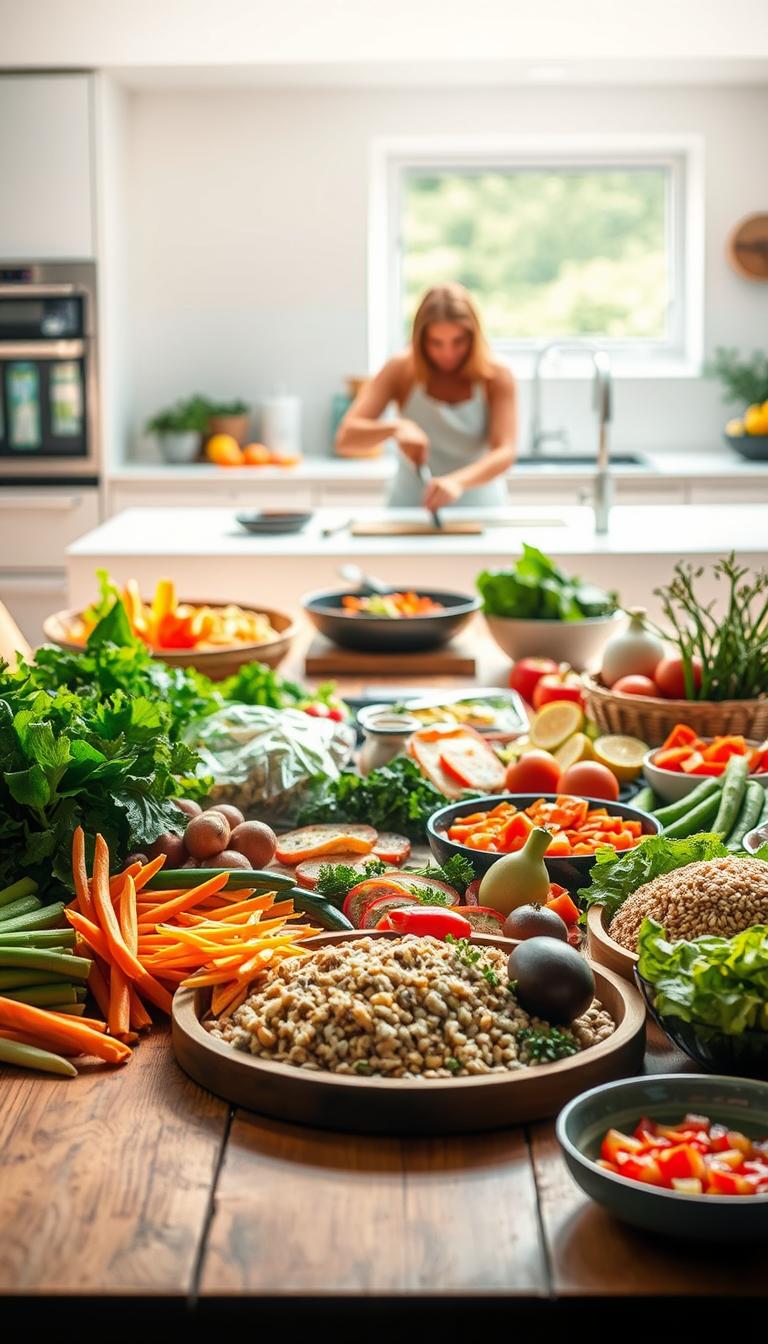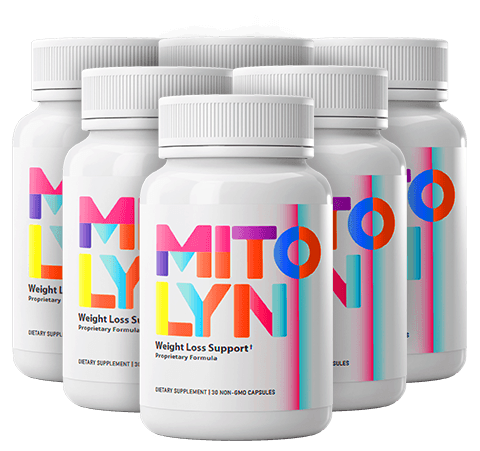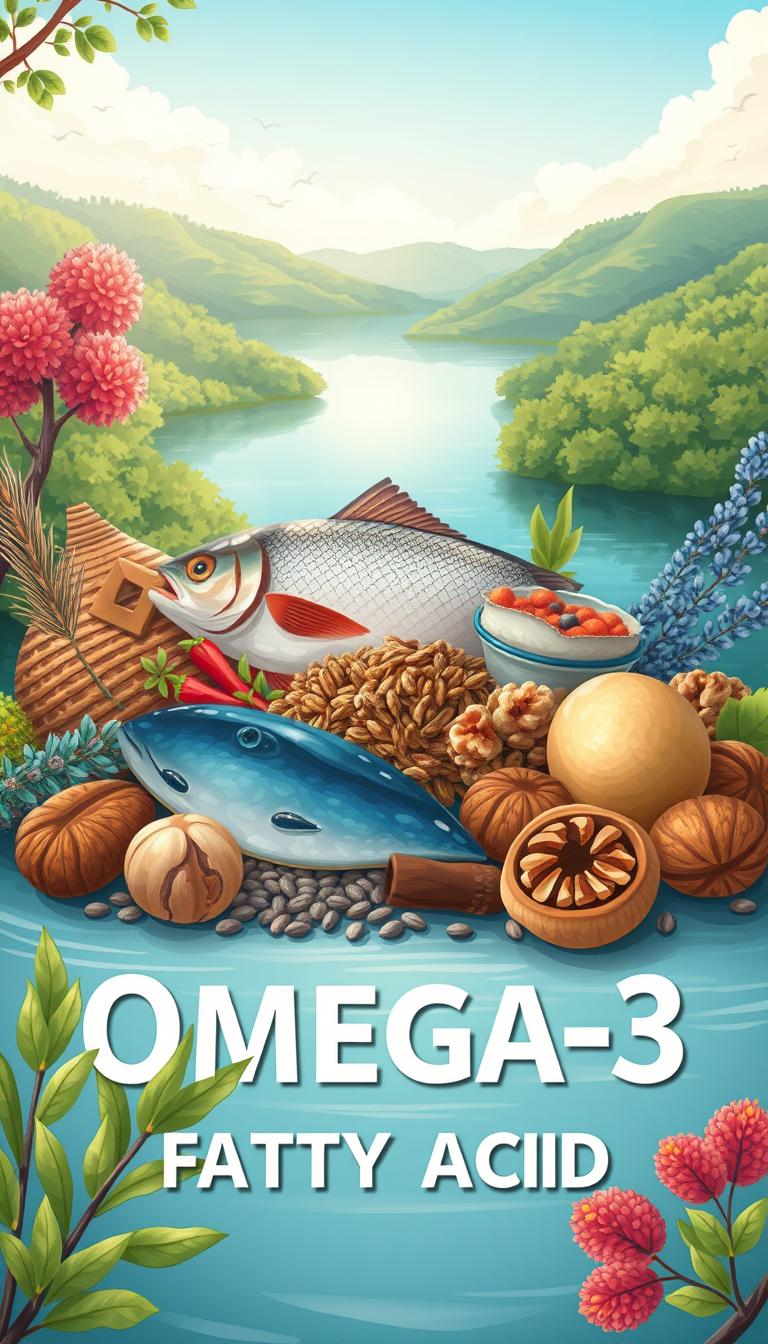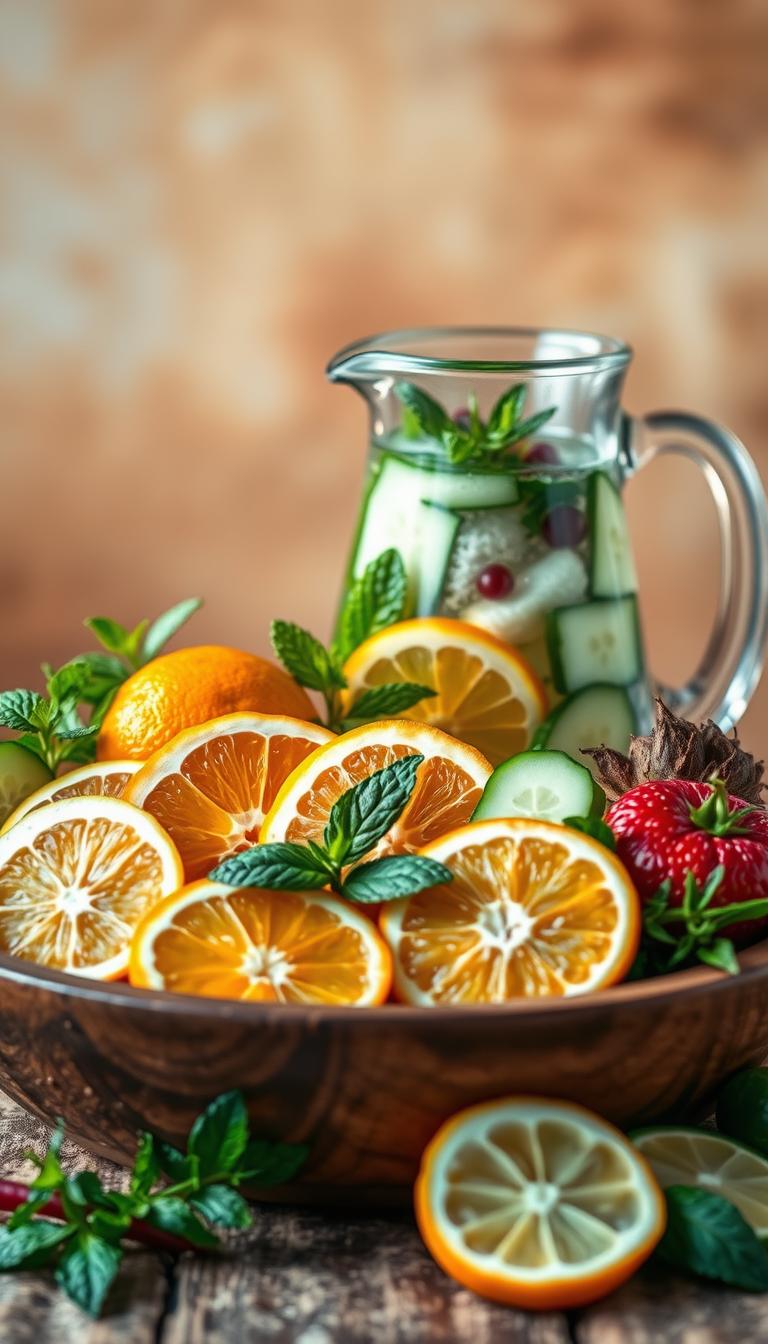
Ever felt tired in the afternoon or had cravings you couldn’t stop? Starting your day with energy, not tiredness, is possible. A no sugar diet is more than just skipping dessert. It’s a path to a brighter, lighter you.
When you stop eating sugar, you’re not missing out. You’re choosing to feel clear, full of life, and healthy. It’s like going from a foggy haze to sharp focus, from bloating to confidence, and from mood swings to calm.
In “Understanding the Importance of Low Sugar Foods”, Lorene Peachey shows how less sugar can change your health. Her 21-day meal plans and science-backed tips help you stop emotional eating. People have lost over 5kg, slimmed down, and gotten clearer skin. It’s not a diet; it’s a fresh start.
Key Takeaways
- Cutting out sugar boosts energy and mental clarity, ending 3pm slumps.
- A sugar-free lifestyle reduces cravings and supports sustainable weight loss.
- Reducing sugar intake improves sleep, mood, and skin health.
- Breaking emotional eating cycles starts with informed choices and tools from resources like Lorene Peachey’s guide.
- Small steps like swapping sugary snacks for low-sugar foods create big changes.
Understanding What a No Sugar Diet Really Means
Starting a no-sugar diet means knowing what to skip and what to keep. Let’s get the basics right. Added sugars, found in things like soda and candy, are bad. But natural sugars, like those in apples, are fine. Here’s how to spot the difference:
Natural vs. Added Sugars: What’s Allowed?
| Allowed (Natural) | Avoid (Added) |
|---|---|
| Fruits, vegetables, plain yogurt | Soda, candy, baked goods, flavored yogurt |
Why Sugar Feels Addictive
Sugar makes your brain release dopamine, which can lead to cravings. This can turn into sugar addiction. Cutting down on refined sugars helps balance your blood sugar and energy.
Realistic Goals for Your Journey
- Focus on whole foods like vegetables, nuts, and lean proteins.
- Use natural alternatives to sugar such as cinnamon or fresh fruit for sweetness.
- Expect cravings to ease within 2–3 weeks as your body adjusts.
A no-sugar diet isn’t about giving up. It’s about picking foods that are good for you. By avoiding added sugars, you’ll see benefits like better skin, more energy, and mood swings will lessen. Start small—read labels, swap processed snacks for veggies, and celebrate your progress!
The Surprising Health Benefits of Cutting Sugar
Choosing to quitting sugar can change your body and mind in amazing ways. You might see clearer skin, steady energy, and fewer cravings in just days. As time goes on, the sugar-free diet benefits get even better, like lowering risks for serious diseases.

- Immediate perks: Sustained energy, fewer mood swings, and better sleep.
- Long-term gains: Lower risk of diabetes, heart disease, and fatty liver disease.
- Physical improvements: Clearer skin, reduced bloating, and stronger immunity.
- Mental boosts: Sharper focus, less anxiety, and better emotional balance.
“After two weeks, I stopped craving sweets and felt lighter. My energy never crashes anymore!” — Participant in a recent Sugar Free Challenge
Science supports these changes. Cutting sugar reduces belly fat linked to diabetes and heart problems. Even teens saw better liver health in just eight weeks. Less sugar means less inflammation, better insulin control, and healthier gut bacteria. Your body uses real nutrients, leading to stable moods and sharper focus.
Every step toward a sugar-free diet benefits journey helps. From clearer skin to stronger joints, the health benefits of no sugar build over time. Ready to see these changes? Start small and watch your body respond.
How to Start Your No Sugar Diet Today
Start with small steps to adopt a sugar-free lifestyle. Follow these tips to smoothly move to a whole foods diet. This diet supports healthy eating.
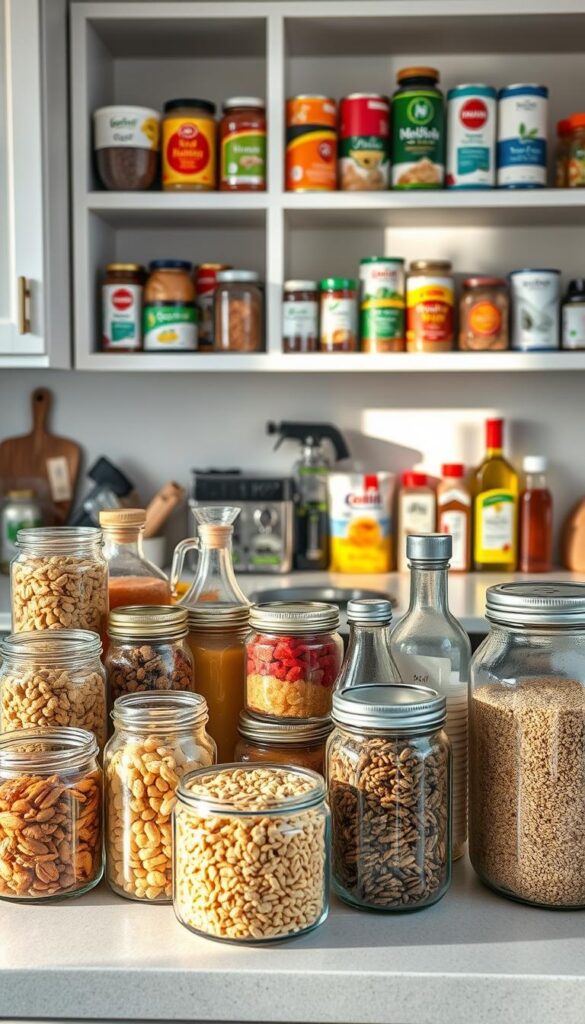
Pantry Clean-Out: What to Remove
Begin by removing obvious sugar sources like candy, soda, and baked goods. Get rid of condiments with added sugars—like ketchup, BBQ sauce, and flavored yogurts. Use unsweetened versions instead. Keep these items off your list:
- Sugary cereals
- Packaged snacks
- Pre-made sauces
Essential Shopping List for Sugar-Free Living
Build a base with whole foods. Stock up on these essentials:
| Category | Examples |
|---|---|
| Proteins | Grilled chicken, lentils, plain Greek yogurt |
| Healthy Fats | Avocados, almonds, olive oil |
| Complex Carbs | Quinoa, oats, sweet potatoes |
Choose items that are minimally processed. This follows a whole foods diet.
Reading Food Labels Like a Pro
Look beyond “sugar-free” claims. Many products use hidden sugar aliases like dextrose, agave, or malt syrup. Even “natural” items like flavored almond milk may add sugar. Always check ingredients for additives.
“Even products labeled ‘no added sugar’ may contain chemical sweeteners. Always read ingredients,” advises nutritionists.
Tracking Your Progress: Apps and Tools
Track meals and moods with apps like MyFitnessPal or a simple notebook. Note cravings and energy levels to spot patterns. Start by reducing sugar in coffee or cereal. The American Heart Association recommends no more than 9 tsp (36g) daily for men and 6 tsp (24g) for women.
Use these tools to stay on track:
- Food journal: Write down meals and cravings
- Barcode scanners: Check sugar content instantly
Congratulations—you’re now ready to embrace a sugar detox that supports long-term health.
Common Challenges and How to Overcome Sugar Cravings
Breaking free from sugar cravings is tough, especially at first. Your body misses the quick energy sugar gives. This can lead to headaches, fatigue, or mood swings.
This adjustment is normal. It means your body is getting used to a healthier way of living.

“Cravings fade within 5-10 days as your brain adjusts. Stay hydrated and focus on whole foods.”
When asugar addiction hits, try these tips:
- Drink water—dehydration can make you feel hungry
- Snack on protein-rich foods like nuts or Greek yogurt
- Chew sugar-free gum (Dave Grotto’s tip reduces cravings by 50%)
Nutritionist Susan Moores says to pair small treats with healthy foods. For example, a banana with dark chocolate sauce. Don’t skip meals, as it makes cravings worse. Try to sleep 7-9 hours a night. Poor sleep boosts hunger hormones.
Exercise for 30 minutes a day to lower stress hormones that make you crave sugar.
Keep a journal to track when you crave sugar. If stress is a trigger, try deep breathing or a short walk. Every small choice helps. Soon, your taste buds will change, and old sugar cravings will go away. You can do it!
Delicious Sugar-Free Meal Planning Ideas
Enjoying meals without added sugar doesn’t mean sacrificing flavor. This sugar-free meal plan uses whole foods and natural alternatives to sugar. It keeps you energized all day. Registered dietitians created these sugar-free recipes to balance taste and nutrition.
“This isn’t deprivation—it’s about energy-boosting meals that leave you feeling full and fabulous.”
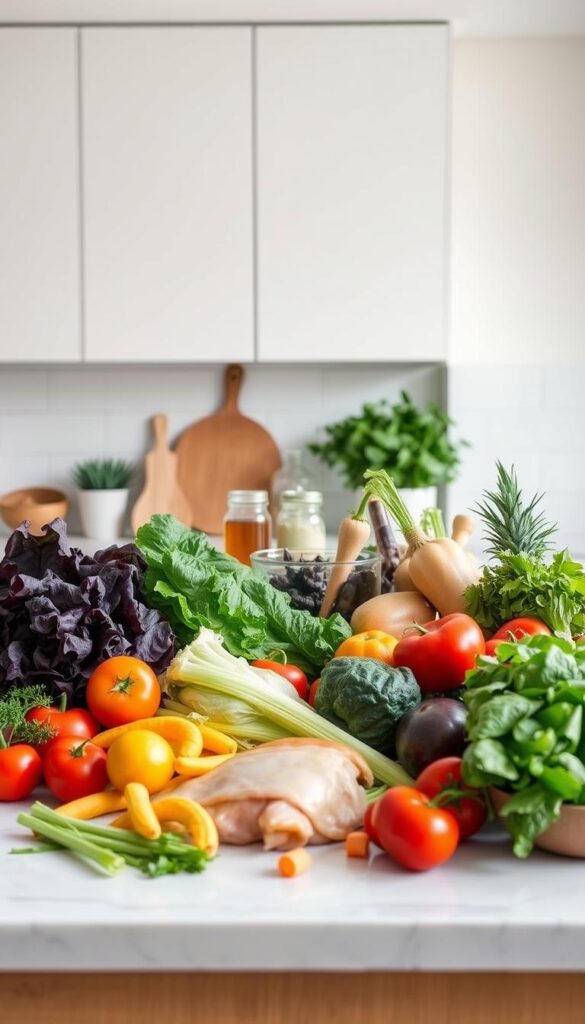
Breakfast Options That Keep You Satisfied
Start your day right with these choices:
- Savory veggie omelets packed with spinach and tomatoes
- Avocado toast on whole grain bread
- Greek yogurt parfaits layered with berries and nuts
Lunch and Dinner Recipes That Don’t Sacrifice Flavor
Discover dishes that deliver bold flavors without sugar:
| Recipe | Sugar Content (g) |
|---|---|
| Lemon Garlic Shrimp with Pasta | 0 |
| Rustic Vegetable Frittata | 2 |
| Sheet-Pan Chicken and Vegetables | 3 |
Smart Snacking Without the Sweet Stuff
Stay fueled with:
- Cucumber slices dipped in hummus
- Roasted chickpeas seasoned with paprika
- Peanut Butter-Date Energy Balls (made with natural sweetness from dates)
Beverages That Won’t Derail Your Progress
Hydrate smartly with:
- Infused water with lemon and cucumber
- Unsweetened almond milk lattes
- Herbal teas like mint or hibiscus
Adjust portions for 1,500 or 2,000 calories by following the plan’s guidelines. Try sugar-free desserts like Muffin-Tin Quiches for a sweet-free treat. Every recipe focuses on whole foods, helping you stay on track without compromise.
Navigating Social Situations on a No Sugar Diet

Living a sugar-free lifestyle doesn’t mean missing out on social events. Here are some tips to help you stay on track and enjoy time with friends:
Dining Out Strategies
Look up menus online or call the restaurant to find healthy options. Ask for no sauces or sugary sides. Carry nuts or veggie sticks to avoid bad choices.
- Request no added syrup or honey.
- Drink water or unsweetened tea instead of soda.
Holidays and Special Occasions
Plan ahead by bringing a sugar-free dish to share. Focus on games or activities instead of desserts. It’s okay to have small treats, enjoy them without guilt.
| Challenge | Solution |
|---|---|
| Buffet temptations | Fill half your plate with proteins and veggies first. |
| Hosts unaware of your diet | Politely explain your healthy eating habits and offer to bring a dish. |
What to Do When You Slip Up
Mistakes happen—don’t let them stop you. Note the slip, then get back on track. Focus on progress, not perfection. Share your struggles for support.
Remember, reducing sugar intake is a journey. Each choice brings you closer to your goals, without losing connection with others.
Potential Side Effects to Watch For

Starting sugar detox can make your body feel a bit off. You might get headaches or feel really tired. These are signs your body is getting used to not having so much sugar.
Most of these symptoms go away in 3–10 days. This is when your body gets back into balance.
| Symptom | Why It Happens | How to Cope |
|---|---|---|
| Headaches | Fluctuating blood sugar balance disrupts hydration and electrolytes levels | Sip water with a pinch of sea salt |
| Fatigue | Reduced sugar intake lowers energy spikes and crashes | Eat small, protein-rich meals every 3 hours |
| Mood swings | Reduced dopamine from quitting sugar affects brain chemistry | Try a 10-minute walk to boost natural endorphins |
You might also feel confused, have trouble sleeping, or really want sugar. This is because your body is learning to use fat for energy instead of sugar. If you feel dizzy or lightheaded, try drinking water with a bit of Himalayan salt to help with electrolytes.
- Drink 8+ ounces of water upon waking
- Track symptoms in a journal to monitor progress
- Consider a gradual reduction if side effects feel overwhelming
If you’re still feeling bad after 2 weeks or have chest pain, see a doctor. Most of these feelings are just your body adjusting to not having so much sugar. Keep going with your detox plan. Your energy and focus will get better as your body heals.
Real-Life Success Stories from Sugar-Free Living

“This challenge has been truly life changing. I went alcohol-free last July and did not gain weight, but the sugar-free lifestyle transformed my energy and focus.”
Real people, from athletes to busy parents, are finding out about the sugar-free diet benefits. They share how cutting sugar changed their lives:
Weight Loss Transformations
- A calisthenics athlete gained strength and stability for advanced moves like straddle planche after reducing sugar.
- One participant stabilized their weight for the first time in years, avoiding midday energy crashes.
- A 40-year-old mom lost 15 lbs in 3 months while boosting muscle tone without calorie counting.
Health Condition Improvements
| Condition | Before | After |
|---|---|---|
| Arthritis | Painful joints | Reduced stiffness |
| IBS | Monthly flare-ups | Regular digestion |
| Acne | Breakouts | Cleared skin |
One person with perimenopause symptoms saw hormone balance improve within weeks of adopting the sugar-free challenge.
Mental Clarity and Energy Level Changes
Many report:
- No more “hangry” moods or afternoon brain fog
- Steady energy for full-day hikes or intense workouts
- Fewer mood swings and better focus at work
“My training sessions feel sharper now,” said the athlete. “The health benefits of no sugar gave me the stamina to push harder.”
Conclusion: Embracing a Sweeter Life Without Sugar
Starting a no sugar diet isn’t about cutting out food. It’s about filling your body with life-giving foods. These foods give you energy and make you think clearer.
Studies show it lowers diabetes and heart disease risks. It also makes your skin better and helps you sleep better.
At first, you might feel cravings strongly. You might get headaches or feel tired. But these feelings go away as your body gets used to it.
Your taste buds will start to see the natural sweetness in foods. Like roasted veggies or apples with cinnamon. You can make tasty dishes without sugar, like Maple-Glazed veggies or snacks sweetened with Stevia.
Tools like MyFitnessPal help you find hidden sugars in foods. You can use things like monk fruit or dates instead of sugar. It’s okay if you’re not perfect. Just keep moving forward.
Every step you take towards less sugar makes you healthier.
By choosing this path, you get to enjoy real food flavors again. You’ll have more energy, better skin, and a sharper mind. Start by replacing one sugary snack a day. See how it changes your life.
This lifestyle is not just temporary. It’s a lasting change. Your body deserves to feel its best. Start today and see how nature’s sweetness can transform your life.
FAQ
What is a no sugar diet?
A no sugar diet means cutting out added sugars. You can still eat natural sugars from fruits and veggies. It boosts your health and happiness.
How do I identify added sugars in food?
Look for sucrose, glucose, fructose, and corn syrup on labels. Also, watch out for “ose” at the end of words. Hidden sugars are in condiments, sauces, and snacks.
What are the expected benefits of cutting sugar?
Less sugar means more energy and clearer thinking. You might also see better digestion, skin, and less cravings. It’s good for your body and mind.
How long does it take to see the effects of a no sugar diet?
Improvements in energy and mood often start in 1-2 weeks. Everyone is different, though.
Are there any withdrawal symptoms when eliminating sugar?
Yes, you might feel tired, irritable, or have headaches and cravings. These feelings usually go away in 3-10 days.
Can I still enjoy desserts on a no sugar diet?
Yes, you can have desserts without added sugars. Use fruits or sugar substitutes that fit your diet. This way, you can still enjoy sweet treats.
How can I handle cravings for sugar?
Drink water, move your body, or do something else to distract yourself. Eating balanced meals with protein and fats helps control cravings.
What should I do when dining out or at social events?
Check menus before going out and ask about ingredients. Choose healthy options. Bringing your own food to share is a good idea too.
Are there any long-term health benefits to a sugar-free diet?
Yes, sticking to a no sugar diet can improve your body and health over time. You might see better body shape, hormonal balance, and gut health. It also lowers the risk of diseases like diabetes and heart disease.
What if I slip up and consume sugar?
If you eat sugar, don’t be too hard on yourself. Just get back on track. Stay positive and avoid feeling like you’ve failed.

